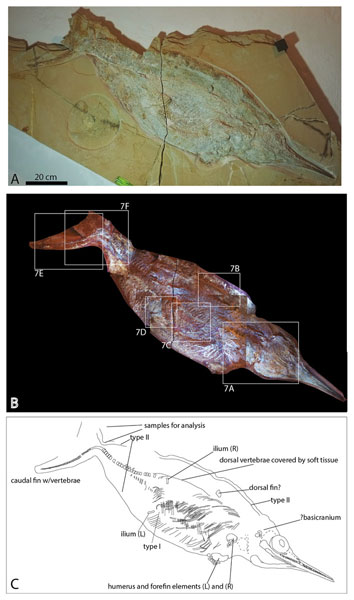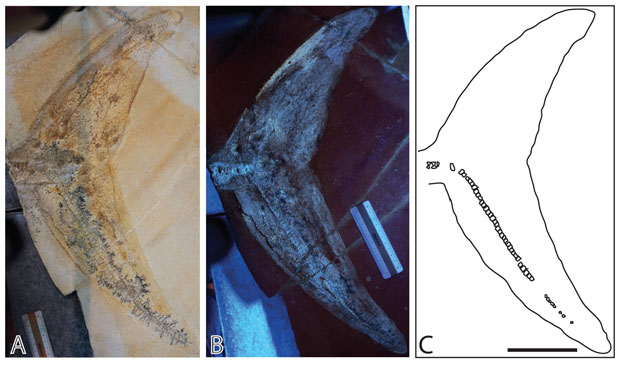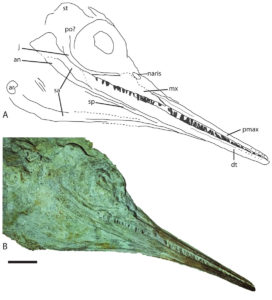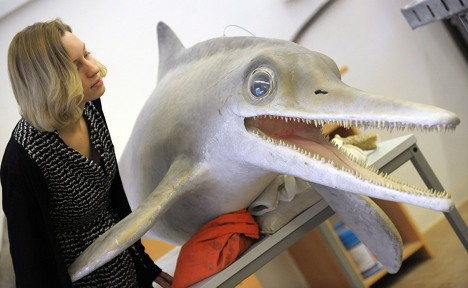Ichthyosaurs Had Blubber According to a New Study
Researchers from the Smithsonian Institute (Washington), the University of Oslo and the Ludwig Maximilian Universität (Munich), have published a paper that describes two ichthyosaur specimens from the famous Upper Jurassic Solnhofen deposits of southern Germany. The fossils, an almost complete Aegirosaurus (JME-SOS-08369) and a tail (JME-SOS183), reveal extensive soft tissue preservation, analysis of which indicates the presence of blubber in these marine reptiles.

Late Jurassic Aegirosaurus sp. (JME-SOS-08369) shown in (A) in normal light and (B) composite picture in UV light indicating location of further close-up images included in the scientific paper. Interpretative drawing (C). Note scale bar equals 20 cm. Picture credit: Delsett et al.
Picture credit: Delsett et al
These amazing fossil specimens representing marine reptiles that lived around 150 million years ago will help scientists to better understand how soft tissue can be preserved in the carcases of vertebrates deposited on the seafloor.
For models and replicas of ichthyosaurs and other prehistoric animals: Ichthyosaurs and Prehistoric Animal Models (CollectA).
Aegirosaurus
Aegirosaurus is a genus of ichthyosaur within the Ophthalmosauridae family. Its fossils are associated with the Upper Jurassic limestone deposits of Solnhofen in southern Germany. These deposits are famous for their vertebrate fossils, although ichthyosaur material is rare. Fossils ascribed to this genus have also been found in Lower Cretaceous strata in south-eastern France (Fischer et al, 2011). This discovery suggests that most Late Jurassic ichthyosaurs came through the end Jurassic extinction and continued to thrive in the Early Cretaceous.
Aegirosaurus was an active, nektonic pursuit predator, probably feeding on small fish and squid.
Picture credit: DPA
Evidence for Blubber
The nearly complete ichthyosaur skeleton (JME-SOS-08369) was excavated in 2009, whereas the second specimen involved in this study (the tail), was originally found in 1926, but not formally described. No genus has been assigned to the tail specimen, although the researchers confidently assign it to the Ophthalmosauridae.

The Late Jurassic ichthyosaur tail (specimen number JME-SOS2183) shown in (A) regular light, under ultraviolet light (B) with an interpretative line drawing (C). Note scale bar equals 10 cm. Picture credit: Delsett et al.
Picture credit: Delsett et al
Soft tissue samples were analysed using X-ray diffraction (XRD) and scanning electron microscopy (SEM) coupled with energy dispersive spectroscopy (EDS) analysis. The analyses confirm the presence of the phosphate mineral apatite, with phosphate most likely derived from the body itself. In addition, a yellow-coloured, amorphous substance was identified, the researchers postulate that this substance represents decomposed blubber.

Skull from Late Jurassic Aegirosaurus sp. (JME-SOS-08369) with (A) interpretative drawing and (B) photograph. Note scale bar equals 5 cm. Picture credit: Delsett et al.
Picture credit: Delsett et al
Identifying Adipocere
The researchers conclude that the detailed analysis of the yellowish, amorphous substance indicates that it is adipocere. This is late-stage post-mortem decomposing fatty acids produced by microorganisms under low oxygen conditions. As adipocere is a typical breakdown product of animal blubber, it is postulated that these ichthyosaurs had blubber to help insulate them, just as many extant marine mammals do. The paper does not address any endothermic implications for this conclusion.
Understanding Ichthyosaur Taphonomy
The two ichthyosaur specimens with their extensive soft tissue preservation will help scientists to interpret the taphonomy (how fossils are preserved) of Solnhofen Archipelago vertebrates. Future research will focus on microscopical and geochemical analysis of different parts of the specimens that have the potential to reveal more information about tissue types.
In addition, the beautifully preserved fossils hold the potential for investigations into the locomotion of ophthalmosaurids, helping scientists to better understand how these marine reptiles moved through the water.
The scientific paper: “The soft tissue and skeletal anatomy of two Late Jurassic ichthyosaur specimens from the Solnhofen archipelago” by Lene L. Delsett, Henrik Friis, Martina Kölbl-Ebert and Jørn H. Hurum published in PeerJ.
The Everything Dinosaur website: Prehistoric Animal Figures.


